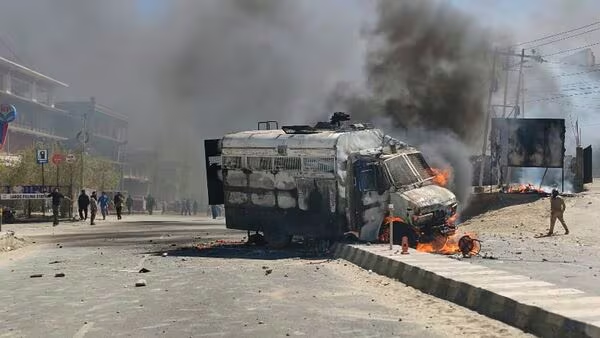
“From hunger strike to a Gen Z protest in Ladakh, youth demand a future with autonomy and dignity.”
The recent unrest in Leh, Ladakh, has become one of the most talked-about political and social events in India, drawing attention from across the country and beyond. Sparked by deep-rooted local grievances, the protests have grown into a larger debate surrounding autonomy, governance, representation, and the role of youth activism in shaping the future of Ladakh.
Here’s a comprehensive breakdown of the key triggers and developments that have shaped the current situation:Gen Z protest in Ladakh,
Statehood Demand:
The protests were fundamentally ignited by activist Sonam Wangchuk’s fervent and highly visible call for Ladakh to be granted full statehood and inclusion under the Sixth Schedule of the Indian Constitution. This demand is not just political but symbolic, aiming to guarantee autonomy, protect land rights, preserve centuries-old traditions, and safeguard Ladakh’s unique cultural heritage. Supporters argue this would give Ladakhans meaningful control over governance, lawmaking, and the development trajectory of the region.
Hunger Strike:
Sonam Wangchuk began a highly symbolic and emotionally charged 15-day hunger strike on September 10, 2025, as a method of peaceful protest to press his demand for constitutional safeguards and full statehood. The hunger strike attracted widespread attention, becoming a focal point for local and national discussions. The gesture mobilized various sections of society, drawing solidarity from youth groups, civil society organizations, and media platforms, amplifying the urgency of the movement.
Youth Mobilization:
The movement quickly gained momentum as Ladakh’s younger generation actively engaged in street protests, discussions, and online campaigns. For many young people, this struggle is about more than politics—Gen Z protest in Ladakh, it represents the fight to preserve their cultural identity, protect their homeland from exploitation, and ensure that development is sustainable and equitable. This mobilization has become a defining feature of the protests, earning it the label of a “Gen Z movement.”
Violence and Clashes:
On September 24, what began as peaceful demonstrations tragically escalated into violent confrontations. Clashes broke out between protesters and law enforcement agencies, involving acts of arson, stone-pelting, and targeted destruction of public property. These violent incidents resulted in the deaths of at least four protesters and injuries to dozens more. The violence marked a turning point in the movement, intensifying tensions and drawing sharper attention to the grievances at hand.
Government Accusations:
The government quickly responded to the unrest by accusing Sonam Wangchuk of making provocative and inflammatory statements that likened the protests to the “Arab Spring” and urged the youth to initiate a “Gen Z revolution.” Authorities claimed that such rhetoric contributed directly to the escalation of violence and unrest, thereby justifying a more stringent approach to maintaining law and order in the region.
Security Crackdown:
In reaction to the intensifying protests, the Leh administration implemented strict curfews, prohibited public gatherings, and deployed additional security forces throughout the city and nearby areas. While these measures aimed to restore peace, they also fueled resentment among the population, intensifying the sense of grievance and further deepening the protest movement. The crackdown became a significant point of contention between the government and protesters.
Wangchuk’s Response:
In the face of these developments, Sonam Wangchuk strongly condemned the violence that erupted during the protests. He urged demonstrators to continue their movement through peaceful means while reaffirming his core demand for constitutional safeguards and full statehood. Wangchuk emphasized the importance of dialogue and constructive engagement with the authorities to resolve the crisis without further escalation.
Post-2019 Concerns:
The removal of Article 370 in 2019 has left a deep and lasting impact on Ladakh’s political landscape. Many residents feel politically sidelined and marginalized, fearing a loss of autonomy, erosion of cultural identity, and exploitation of land and resources without adequate representation. These concerns have become central to the current protests, giving the movement a broader historical and political dimension.
Environmental Concerns:
Activists have also highlighted significant environmental issues as part of the movement. They point to the ecological consequences of increased militarization and large-scale infrastructure projects in Ladakh, arguing that these activities threaten the fragile ecosystem, endanger biodiversity, and undermine the sustainability of the region. Environmental protection has thus become an integral part of the protest agenda.
Core Demand:
At the heart of the protests lies the demand for full statehood and Sixth Schedule protections. Protesters argue that these measures will ensure meaningful autonomy, safeguard Ladakh’s cultural and natural heritage, and guarantee that local communities have a decisive say in matters affecting their land and future. The demand represents both a political aspiration and a broader movement to preserve identity, dignity, and self-determination.
The situation remains tense, with ongoing dialogue between local leaders and the central government. Scheduled talks in early October 2025 are expected to play a decisive role in determining Ladakh’s future and could either resolve or further intensify the movement.
FOR MORE BLOGS – beyondthepunchlines.com

 Add to favorites
Add to favorites







